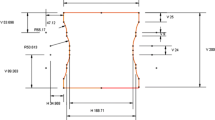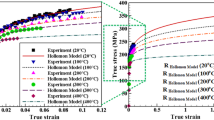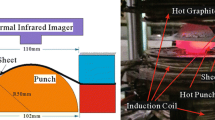Abstract
It is impossible to obtain the forming limit curve (FLC) by full zone hydraulic forming test under quasi-static (QS) condition since the liquid will leak from the notches of the specimen once the pressure increases. In this study, a novel method is proposed to investigate the frictionless full zone hydraulic FLC of AA5A06 under high strain rate (HSR) condition based on the impact hydroforming technology (IHF). It is found that the FLC is increased significantly by IHF compared with the quasi-static rigid punch (QS-R) forming and the quasi-static hydraulic (QS-H) forming. Differentiating with the QS-H, the increase amounts of FLC at the biaxial tension zone and the tension-compression zone are notably different for IHF. Additionally, the theoretical calculations of FLC is conducted by using M-K model combining with Hill48 anisotropic yield criterion under QS and HSR conditions. The results calculated by the M-K model reasonably agree with the ones obtained from experimentation under QS and HSR condition, and a higher initial thickness ratio is assigned for HSR considering the neck postponing effect of inertia.

















Similar content being viewed by others
Abbreviations
- QS:
-
quasi-static
- HSR:
-
high strain rate
- FLC:
-
forming limit curve
- QS-R:
-
quasi-static rigid punch
- QS-H:
-
quasi-static hydraulic punch
- HF:
-
hydroforming
- IHF:
-
impact hydroforming
- M-K:
-
Marciniak and Kuczynski model
- SHTB:
-
Split Hopkinson Tensile Bar test
- SHPB:
-
Split Hopkinson Pressure Bar test
- RD:
-
rolling direction
- TD:
-
transverse direction
References
Zhang SH (1999) Developments in hydroforming. J Mater Proc Technol 91:236–244
Zhang SH (2004) Recent developments in sheet hydroforming technology. J Mater Proc Technol 151:237–241
Suttner S, Merklein M (2016) Experimental and numerical investigation of a strain rate controlled hydraulic bulge test of sheet metal. J Mater Proc Technol 235:121–133
Lee JY, Xu L, Barlat F, Wagoner RH, Lee MG (2013) Balanced biaxial testing of advanced high strength steels in warm conditions. Exp Mech 53:1681–1692
Grolleau V, Gary G, Mohr D (2008) Biaxial testing of sheet materials at high strain rates using viscoelastic bars. Exp Mech 48:293–306
Banabic D, Lazarescu L, Paraianu L, Ciobanu I, Nicodim I, Comsa DS (2013) Development of a new procedure for the experimental determination of the Forming Limit Curves. CIRP Ann 62:255–258
Chen YY, Tsai YC, Huang CH (2014) Integrated Hydraulic bulge and forming limit testing method and apparatus for sheet metals. Key Eng Mater 626:171–177
Zhang L, Min JY, Carsley JE, Stoughton TB, Lin JP (2017) Experimental and theoretical investigation on the role of friction in Nakazima testing. Int J Mech Sci 133:217–226
Ma Y, Xu Y, Zhang SH, Banabic D, El-Aty A, Chen A, Chen DY (2018) Investigation on formability enhancement of 5A06 aluminium sheet by impact hydroforming. CIRP Ann 67:281–284
Broomhead P, Grieve RJ (1982) The effect of strain rate on the strain to fracture of a sheet steel under biaxial tensile stress conditions. J Eng Mater Technol 104:102–106
Ramezani M, Ripin ZM (2010) Combined experimental and numerical analysis of bulge test at high strain rates using split Hopkinson pressure bar apparatus. J Mater Process Technol 210:1061–1069
Justusson B, Pankow M, Heinrich C, Rudolph M, Waas AM (2013) Use of a shock tube to determine the bi-axial yield of an aluminum alloy under high rates. Int J Impact Eng 58:55–65
Golovashchenko SF (2007) Material formability and coil design in electromagnetic forming. J Mater Eng Perform 16:314–320
Yu H, Zheng Q (2019) Forming limit diagram of DP600 steel sheets during electrohydraulic forming. Int J Adv Manuf Technol 104:743–756
Verleysen P, Peirs J, Van Slycken J, Faes K, Duchene L (2011) Effect of strain rate on the forming behaviour of sheet metals. J Mater Process Technol 211:1457–1464
Chuang KC, Ma CC, Chang CK (2014) Determination of dynamic history of impact loadings using polyvinylidene fluoride (pvdf) films. Exp Mech 54:483–488
Bauer F (2004) PVDF shock compression sensors in shock wave physics. AIP Conf Proc 706:1121–1124
Maris C, Hassannejadasl A, Green DE (2016) Comparison of quasi-static and electrohydraulic free forming limits for DP600 and AA5182 sheets. J Mater Process Technol 235:206–219
El-Magd E, Abouridouane M (2006) Characterization, modelling and simulation of deformation and fracture behaviour of the light-weight wrought alloys under high strain rate loading. Int J Impact Eng 32:741–758
Mirone G, Corallo D, Barbagallo R (2017) Experimental issues in tensile Hopkinson bar testing and a model of dynamic hardening. Int J Impact Eng 103:180–194
Marciniak Z, Kuckzynski K (1967) Limit strains in the process of stretch-forming sheet metal. Int J Mech Sci 9:609–620
Johnson GR, Cook WH (1983) A constitutive model and data for metals subjected to large strains, high strain rates and high temperatures. Proceedings of the 7th International Symposium on Ballistics, pp 541–547
Hill R (1948) A theory of the yielding and plastic flow of anisotropic metals. Proc Roy Soc Lond A 193:281–297
Kim SB, Huh H, Bok HH, Moon MB (2011) Forming limit diagram of auto-body steel sheets for high-speed sheet metal forming. J Mater Process Technol 211:851–862
Ganjiani M, Assempour A (2007) An improved analytical approach for determination of forming limit diagrams considering the effects of yield functions. J Mater Process Technol 182:598–607
Zaera R, Rodríguez-Martínez JA, Vadillo G, Fernández-Sáez J, Molinari A (2015) Collective behaviour and spacing of necks in ductile plates subjected to dynamic biaxial loading. J Mech Phys Solids 85:245–269
Jacques N (2020) An analytical model for necking strains in stretched plates under dynamic biaxial loading. Int J Solids Struct 200:198–212
N’souglo KE, Jacques N, Rodríguez-Martínez JA (2021) A three-pronged approach to predict the effect of plastic orthotropy on the formability of thin sheets subjected to dynamic biaxial stretching. J Mech Phys Solids 146:104189
Xue Z, Vaziri A, Hutchinson JW (2008) Material aspects of dynamic neck retardation. J Mech Phys Solids 56:93–113
Ghosh AK (1977) The influence of strain hardening and strain-rate sensitivity on sheet metal forming. J Eng Mater Technol 99:264–274
Hutchinson JW, Neale KW (1977) Influence of strain-rate sensitivity on necking under uniaxial tension. Acta Metall 25:839–846
Author information
Authors and Affiliations
Corresponding author
Ethics declarations
Conflict of interests
The authors declare that they have no conflict of interest.
Additional information
Publisher’s Note
Springer Nature remains neutral with regard to jurisdictional claims in published maps and institutional affiliations.
Rights and permissions
About this article
Cite this article
Ma, Y., Chen, Sf., Chen, Dy. et al. Determination of the forming limit of impact hydroforming by frictionless full zone hydraulic forming test. Int J Mater Form 14, 1221–1232 (2021). https://doi.org/10.1007/s12289-021-01635-7
Received:
Accepted:
Published:
Issue Date:
DOI: https://doi.org/10.1007/s12289-021-01635-7




